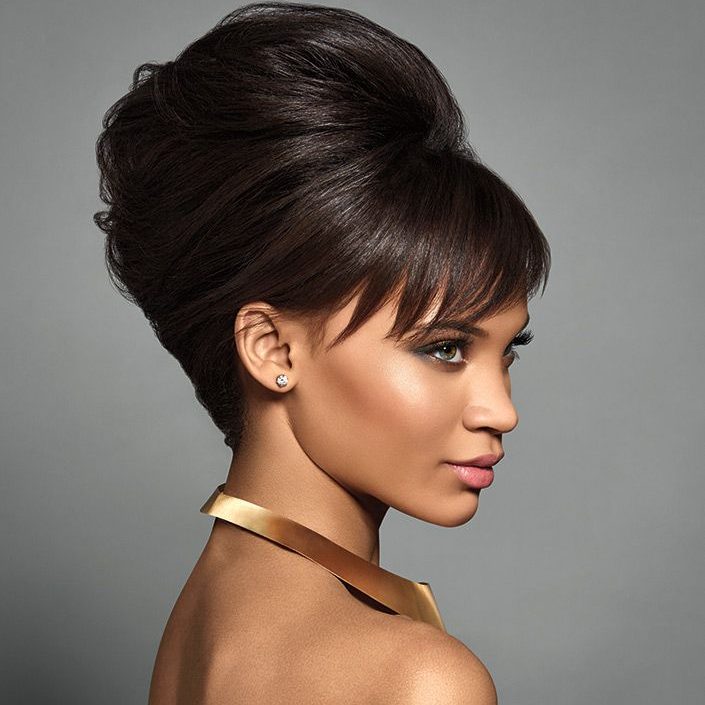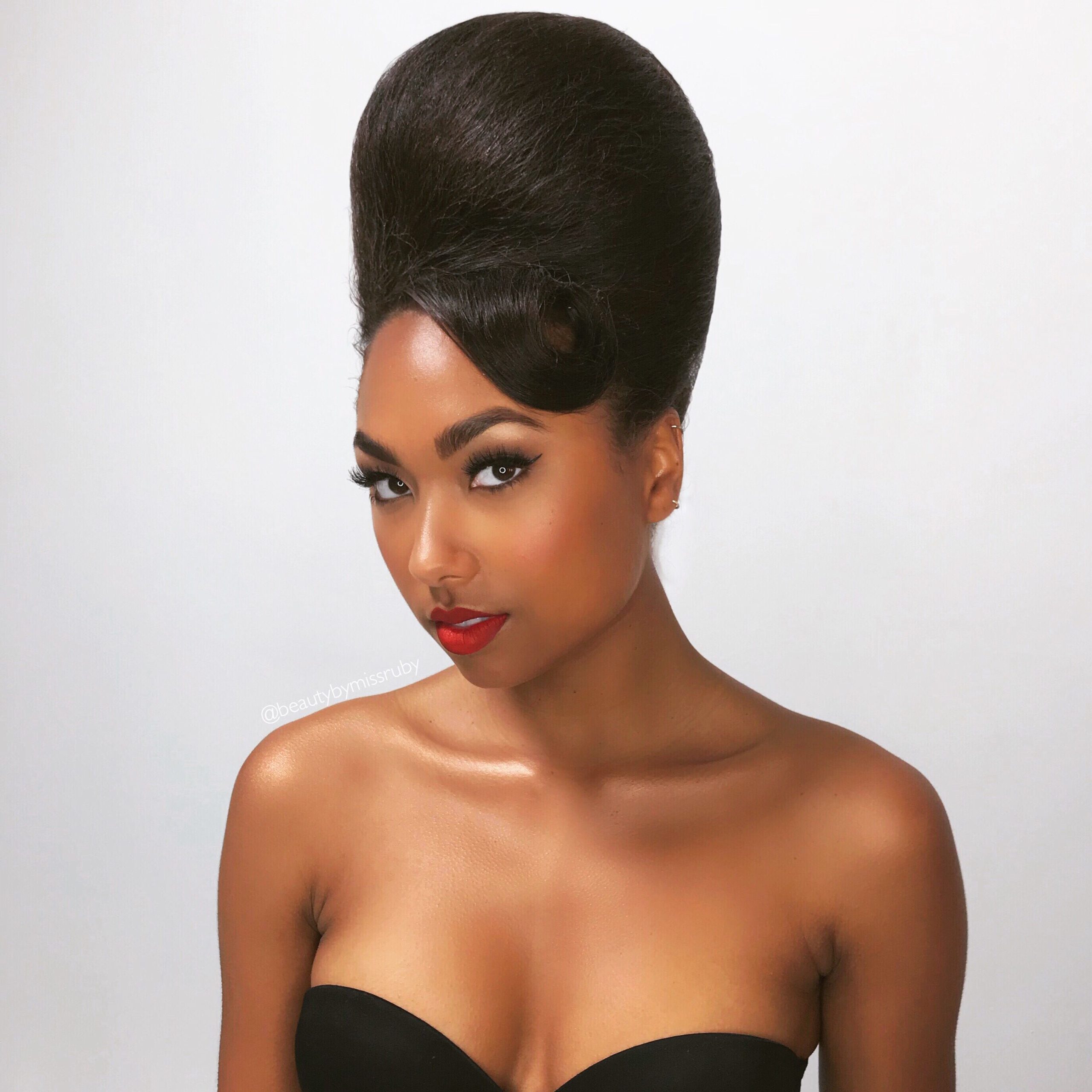
The Beehive Hairstyle: A Timeless Icon of Retro Glamour
The Rise of the Beehive
The beehive hairstyle emerged as a cultural phenomenon in the 1960s. It quickly became a symbol of feminine allure and sophistication. This towering hairdo captivated women across America and beyond. Its distinctive shape resembled a conical beehive, hence its name. The style’s popularity soared among celebrities, socialites, and everyday women alike. It represented a departure from the softer, more natural looks of the previous decade. The beehive embodied the changing attitudes and aspirations of women in the 1960s.
Margaret Vinci Heldt, a Chicago-based hairstylist, created the beehive in 1960. She responded to a challenge from a hairstyling magazine to develop a new look for the decade. Heldt drew inspiration from a black fez-style cap she owned. She aimed to create a style that would easily fit under the small hat. The result was a tall, rounded silhouette that defied gravity. Heldt’s creation quickly caught on, spreading from her salon to the wider world. The beehive became a defining look of the era, shaping fashion and popular culture.
The beehive’s popularity stemmed from its versatility and impact. It suited various face shapes and hair types. The style projected an air of elegance and sophistication. It allowed women to appear taller and more statuesque. The beehive also aligned with the fashion trends of the time. It complemented the sleek, mod clothing styles popularized by designers like Mary Quant. Celebrities like Audrey Hepburn and Brigitte Bardot embraced the look. Their influence further cemented the beehive’s status as a must-have style. The beehive became more than just a hairstyle; it was a statement of feminine power and confidence.
Crafting the Perfect Beehive
Creating a beehive hairstyle requires skill, patience, and the right tools. The process begins with clean, dry hair. Stylists often recommend using day-old hair for better hold. The first step involves teasing or backcombing the hair. This creates volume and structure at the crown. Stylists use a fine-toothed comb to gently tease small sections of hair. They work from the roots towards the ends, creating a matted base. This foundation gives the beehive its characteristic height and shape.
After teasing, the next step is smoothing and shaping the outer layer of hair. Stylists use a brush to gently smooth the surface of the teased sections. They carefully shape the hair into the desired conical form. Pins and hairspray help secure the shape in place. The front and sides of the hair are then styled to frame the face. Some variations leave loose strands or bangs for a softer look. Others incorporate all the hair into the updo for a more dramatic effect. The final step involves generous application of hairspray. This ensures the style holds its shape throughout the day or night.
Maintaining a beehive required dedication and care. Women often slept with their hair wrapped in scarves to preserve the style. They used special long-handled combs to gently reshape and fluff the hair. Regular touch-ups with hairspray helped maintain the beehive’s structure. Some dedicated enthusiasts kept their beehives intact for days or even weeks. This practice led to jokes about small objects getting lost in the depths of the hairstyle. While exaggerated, these stories highlighted the beehive’s impressive staying power.
The Beehive in Popular Culture
The beehive hairstyle left an indelible mark on popular culture. It appeared in countless films, television shows, and magazine covers. Iconic figures like Dusty Springfield and The Ronettes made the beehive their signature look. The style became synonymous with 1960s glamour and sophistication. It represented a particular moment in time, capturing the spirit of an era. The beehive’s cultural impact extended beyond its initial heyday. It continues to influence fashion and beauty trends decades later.
In film, the beehive became a visual shorthand for certain character types. It often signified a sophisticated, urban woman. Characters with beehives exuded confidence and style. The 1961 film “Breakfast at Tiffany’s” featured Audrey Hepburn sporting a elegant beehive. This image became one of the most recognizable in cinema history. Other films used the beehive to evoke the 1960s in period pieces. The hairstyle helped establish the setting and mood of stories set in that era.
Music and the beehive shared a special connection. Many female singers of the 1960s adopted the style. It became particularly associated with girl groups and soul singers. The Supremes, with their matching beehives, epitomized this look. Their polished image, complete with towering hairdos, set a new standard for glamour in music. The beehive also featured prominently in the mod and Motown scenes. It complemented the sleek, coordinated outfits worn by many performers of the time.
Television embraced the beehive as well. Characters on popular shows sported variations of the style. It appeared on both fictional characters and real-life personalities. News anchors and talk show hosts adopted the beehive for its polished, professional appearance. The style conveyed authority and poise on screen. In sitcoms, the beehive often signified a fashionable or status-conscious character. Its presence on television helped normalize the style for everyday women.
The Beehive’s Evolution and Legacy
As fashion trends shifted, the beehive adapted and evolved. The late 1960s and early 1970s saw a move towards more natural hairstyles. The classic beehive began to fall out of everyday favor. However, it never completely disappeared from the fashion landscape. The style continued to appear in various forms. It influenced other updos and volume-heavy styles. The basic techniques used to create a beehive remained relevant in hairstyling.
The 1980s brought a resurgence of big hair, including beehive-inspired looks. Punk and new wave subcultures embraced exaggerated versions of the style. These modern interpretations added edge to the once-conservative look. Pop stars like Cyndi Lauper incorporated elements of the beehive into their iconic hairstyles. The 1990s saw a revival of 1960s fashion, including nods to the beehive. Films and music videos set in or inspired by the 1960s reintroduced the style to a new generation.
In the 21st century, the beehive continues to make appearances on runways and red carpets. Fashion designers and celebrities often reference the style for its retro appeal. Modern interpretations tend to be looser and less structured than the original. They capture the essence of the beehive while adapting it to contemporary tastes. The style has become a go-to for vintage-themed events and costume parties. It instantly evokes the glamour and sophistication of a bygone era.
The beehive’s influence extends beyond direct recreations of the style. Its emphasis on volume at the crown has inspired countless modern hairstyles. The techniques used to create a beehive, such as teasing and smoothing, remain staples in hairstyling. The beehive’s legacy can be seen in voluminous updos, high ponytails, and even some bridal hairstyles. Its impact on hair fashion continues to be felt decades after its initial popularity.
Recreating the Beehive for Modern Times
Today’s stylists have adapted the beehive for contemporary tastes. Modern versions often feature softer, more relaxed silhouettes. They incorporate texture and movement while maintaining the classic height. Stylists use updated products and tools to achieve a more natural look. Heat styling tools like curling irons and flat irons help create smoother finishes. Volumizing sprays and dry shampoos replace the heavy hairsprays of the past. These products provide hold and texture without stiffness.
For special occasions, some still opt for a more traditional beehive. Weddings, proms, and retro-themed events often feature updated takes on the classic style. Stylists blend modern techniques with vintage inspiration. They might incorporate braids, twists, or loose curls into the beehive structure. These elements add visual interest and a contemporary edge. Accessories like jeweled pins or flowers can customize the look. The goal is to capture the essence of the beehive while making it feel fresh and relevant.
DIY versions of the beehive have gained popularity through social media and beauty blogs. Online tutorials teach techniques for creating beehive-inspired looks at home. These often focus on achieving volume and height without the need for extensive teasing. Foam padding or “donut” hair accessories help create the rounded shape. Tutorials also offer tips for making the style last, using modern products and techniques. This accessibility has helped introduce the beehive to a new generation of fashion enthusiasts.

The Cultural Significance of the Beehive
The beehive hairstyle represents more than just a fashion trend. It symbolizes a pivotal moment in women’s history. The 1960s saw significant changes in women’s roles and expectations. The beehive, with its bold and unapologetic presence, reflected these shifts. It required time, effort, and skill to create and maintain. This dedication to appearance was both criticized and celebrated. Some viewed it as a form of self-expression and empowerment. Others saw it as a continuation of restrictive beauty standards.
The beehive’s association with female singers and performers is particularly significant. It became a visual representation of women claiming space in the public eye. The style’s height and volume commanded attention. It complemented the powerful voices and personalities of many 1960s divas. The beehive helped create a strong, feminine aesthetic in male-dominated industries. It allowed women to project confidence and sophistication on their own terms.
In retrospect, the beehive serves as a time capsule of 1960s culture. It embodies the optimism, sophistication, and changing social norms of the era. The style’s enduring popularity in costume and popular culture speaks to its iconic status. It instantly evokes a specific time and place in collective memory. The beehive has become shorthand for 1960s feminine glamour. Its cultural resonance extends far beyond its original context.
The beehive’s legacy also raises questions about beauty standards and self-expression. It represents a highly stylized, labor-intensive approach to beauty. This contrasts with more recent trends towards natural, low-maintenance looks. The ongoing fascination with the beehive reflects a tension between artifice and authenticity in beauty. It challenges viewers to consider how hairstyles and fashion choices reflect broader cultural values. The beehive remains a potent symbol of feminine power, nostalgia, and the ever-changing nature of beauty ideals.



